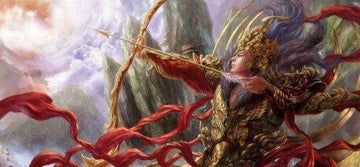Chinese mythology is a rich and diverse collection of stories and legends that have been passed down through the centuries. From powerful gods and goddesses to legendary heroes and villains, the characters of Chinese mythology have captured the imagination of people all over the world.
In this article, we will explore the 11 most important figures in Chinese mythology, their stories, and their significance in Chinese culture.
1. Nüwa (女娲)
Nüwa is a goddess who is said to have created humans out of clay. In Chinese mythology, she is often depicted as a serpent with a woman's head. According to legend, Nüwa repaired the sky after it was damaged by Gong Gong, a water god who caused chaos and floods. She is also credited with creating the first musical instruments and inventing the marriage ceremony. Nüwa is a symbol of creation, order, and harmony.
2. Fuxi (伏羲)
Fuxi is a legendary figure who is said to have taught humans how to write, fish, hunt, and domesticate animals. He is often depicted as a half-human, half-serpent creature. According to legend, Fuxi and his sister Nüwa created humans out of clay. Fuxi is associated with the concept of yin and yang and is considered to be the inventor of the bagua, a system of eight trigrams used in divination.
3. Chang'e (嫦娥)
Chang'e is a goddess of the moon who is celebrated during the Mid-Autumn Festival. According to legend, Chang'e was once a beautiful woman who drank a potion of immortality and flew to the moon. Her husband, Hou Yi, was a skilled archer who shot down nine of the ten suns that were causing the earth to scorch. Chang'e is a symbol of beauty, love, and devotion.
4. Hou Yi (后羿)
Hou Yi was a skilled archer who saved the world by shooting down nine of the ten suns that were scorching the earth. Legend has it that there were originally ten suns that rose each day, causing the earth to dry up and people to suffer. Hou Yi was a skilled archer and was tasked with shooting down nine of the suns. He succeeded, but was banished from heaven as a result. He later became the husband of the moon goddess Chang'e, and the two are often depicted together.
5. Jade Emperor (玉皇)
The Jade Emperor is the highest deity in Chinese traditional religion and Taoism. He is considered the ruler of all gods and the supreme judge of human affairs. According to mythology, he was born as a prince named Xuanyuan Huangdi, but he became the Jade Emperor after proving his worthiness through his virtue and wisdom. The Jade Emperor is often depicted wearing a golden crown and a red robe, and he is worshiped in temples throughout China.
6. Sun Wukong (孙悟空)
Sun Wukong, also known as the Monkey King, is a legendary hero who features prominently in the novel "Journey to the West." He is a mischievous and powerful monkey who possesses extraordinary strength and magical powers. Sun Wukong accompanies the monk Xuanzang on a journey to retrieve Buddhist scriptures. He is a symbol of rebellion, strength, and loyalty.
7. Ao Guang (敖广)
Ao Guang is one of the Four Dragon Kings in Chinese mythology, and he rules over the East Sea. He is often depicted as a dragon with a human face, and is considered a powerful and influential deity. Ao Guang is associated with rain and storms, and is believed to have the power to control the weather. He is also featured in the classic novel "Journey to the West," where he tries to capture the Monkey King Sun Wukong.
8. Nezha (哪吒)
Nezha is a popular deity in Chinese mythology, often depicted as a young boy with three heads and six arms. He is known as a powerful and fearless warrior, and is often associated with protection and good fortune. According to legend, Nezha was born as a ball of flesh, but was brought to life by the Taoist master Taiyi Zhenren. Nezha is also featured in the classic novel "Fengshen Yanyi," where he helps the gods fight against the evil demons.
9. Yu the Great (大禹)
Yu the Great is a legendary figure in Chinese mythology, known for his role in controlling the Great Flood. According to legend, the world was once plagued by a massive flood, and Yu was tasked with building canals and levees to control the waters. With his perseverance and ingenuity, Yu was able to succeed in his task, and is credited with saving the world from destruction. Yu is also known for his virtues of honesty, diligence, and fairness, and is often praised as a model ruler in Chinese history.
10. Zhong Kui (钟馗)
Zhong Kui is a legendary figure who is worshipped as a god of exorcism and protection against evil spirits. According to legend, Zhong Kui was a scholar who was denied a high-ranking government position due to his disfigured appearance. He committed suicide but was later appointed as the King of Ghosts and Demons. Zhong Kui is often depicted as a fierce warrior with a large sword.
11. Erlang Shen (二郎神)
Erlang Shen is a god with the ability to see through falsehoods and illusions. He is often depicted with a third eye on his forehead, and is known for his ability to capture demons and monsters. He is also associated with the Chinese martial art of wushu, and is said to have created his own style of martial arts. Erlang Shen is often depicted with a dog, which is said to be his companion.
These eleven figures are some of the most important and revered in Chinese mythology. Each has their own unique story and significance, and their influence can be seen in various aspects of Chinese culture, including art, literature, and even everyday life. Their tales continue to be passed down through the generations, serving as a reminder of the rich history and cultural heritage of China.




